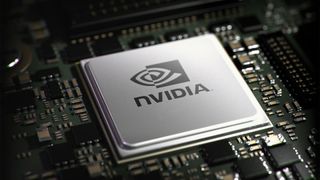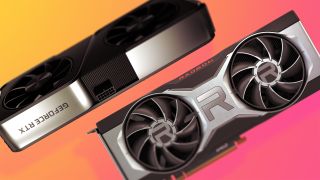Nvidia's RTX 40-series GPUs look set for a big increase in shader count and L2 cache
More of everything.

The fallout from the weekend cyberattack on Nvidia continues. It seems like we’re getting daily drips of information as the hackers attempt to pressure Nvidia to cave into demands including the removal of LHR mining limiters.
The first bit of new information indicates that the RTX 40 GPUs will contain significantly higher shader counts than those of RTX 30 GPUs. Starting at the top of the range, the AD102 GPU is set to include up to 18432 so-called CUDA cores. That's a huge jump from the maximum 10752 of the GA102 that you’d find in the fully unlocked (and for now non-existent) RTX 3090 Ti.
The AD103 GPU could end up as the flagship laptop GPU, as the current GA103 is now. It could also end up in cards like a hypothetically named RTX 4070. It carries the same 10752 shader count of the GA102, and though that count is likely to be that of the fully unlocked chip, it could mean that a next gen RTX 4070 Ti will deliver performance on par with - if not better- than an RTX 3090.
The GPUs from lower in the range don’t get as large a bump in shader count. The AD104, with up to 7680 cores is set to replace the 6144 core GA104, as found in the RTX 3070 Ti. We can expect this to end up in RTX 4060 Ti and 4070 class cards. Of course, we are a long way from launch and even if the GPUs themselves are in full production right now, we don’t know anything about yields. Nvidia will certainly harvest cut down variants like they do now. Clocks and shader counts for individual models are likely not finalised at this stage.

How to buy a graphics card: tips on buying a graphics card in the barren silicon landscape that is 2022
News of the shader count increase isn’t the only Ada Lovelace leak today. On Twitter, @harukaze5719 posted a nice summary and comparison table. Nvidia is set to dramatically increase the L2 cache size of its new GPUs. The increases are so big that current L2 cache sizes are puny in comparison.
Starting with the AD102, it's set to include up to 96MB of L2, compared to just 6MB of the current GA102. The AD103 has up to 64MB vs 4MB of the GA103 and the AD104 packs in 48MB vs the 4MB of the GA104.
So then, let's summarize about Lovelace and Hopper...@kopite7kimi @xinoassassin1 pic.twitter.com/hioRcvn8fbMarch 2, 2022
These increases dramatically alter the architecture and if optimised correctly, could deliver very impressive performance gains, not unlike AMD was able to achieve with its similar Infinity Cache. It lessens the need for a huge bandwidth increase that would be required to get the best out of all of those shaders. 192, 256 and 382-bit bus widths combined with a huge L2 cache should be enough to cover the bandwidth requirements of RTX 40 cards. In theory anyway. We’ll need to test that out for ourselves to know for sure.
The biggest gaming news, reviews and hardware deals
Keep up to date with the most important stories and the best deals, as picked by the PC Gamer team.
So, Ada Lovelace cards appear to have a little bit more of everything. More shader cores (or CUDA cores to use Nvidia’s naming convention), much more L2 cache and higher clocks thanks in part to TSMC’s 5nm process. Sadly though, there are rumours of similarly dramatic increases in power consumption, though we believe that rumours of up to 850W are all but impossible for a consumer card. Don’t be surprised to see 500W or more though. That’s scary enough.
Both Nvidia and AMD are gearing up to take the fight to each other for the hearts, minds and dollars of gamers. Along with AMD’s Zen 4 and Intel’s 13th Gen Raptor Lake, the second half of 2022 is looking like a barnstormer of time to upgrade.

Chris' gaming experiences go back to the mid-nineties when he conned his parents into buying an 'educational PC' that was conveniently overpowered to play Doom and Tie Fighter. He developed a love of extreme overclocking that destroyed his savings despite the cheaper hardware on offer via his job at a PC store. To afford more LN2 he began moonlighting as a reviewer for VR-Zone before jumping the fence to work for MSI Australia. Since then, he's gone back to journalism, enthusiastically reviewing the latest and greatest components for PC & Tech Authority, PC Powerplay and currently Australian Personal Computer magazine and PC Gamer. Chris still puts far too many hours into Borderlands 3, always striving to become a more efficient killer.
Most Popular






